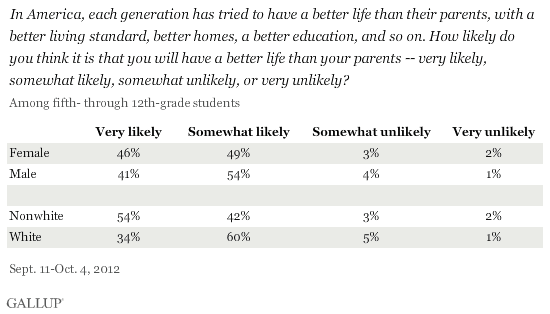WASHINGTON, D.C. -- American youth have little doubt that they will have a better life than their parents. Almost all fifth- through 12th-graders are optimistic about the future, saying they are very likely (43%) or somewhat likely (52%) to have a better standard of living, better homes, and a better education than their parents. A combined 5% of young people say the possibility of having a better life than their parents is somewhat or very unlikely.

Students' strongly positive expectations for their future contrast sharply with American adults' guarded outlook about this country's next generation. Adults are evenly divided about whether it is likely (49%) or unlikely (50%) that today's youth will have a better life than them, according to a Dec. 14-17, 2012, USA Today/Gallup poll that asked the same question of Americans aged 18 and older.
Sixth- and Ninth-Graders, Girls, and Nonwhite Youth Are Most Optimistic
Sixth- and ninth-grade students are the most positive in their assessment of the future. More than half (51%) of youth in the sixth and ninth grades say that they are very likely to outpace their parents. Perhaps the onset of middle school and high school get students excited about their future lives.
Forty-six percent of girls versus 41% of boys say it is very likely that they will have a better future than their parents had. Girls in all grades are also marginally more optimistic than boys about their chances of exceeding their parents' standard of living.

More than half (54%) of nonwhite students say that it very likely that their lives will be better than their parents'. Slightly more than a third (34%) of white students are as confident in their prospects. The greater optimism of nonwhite students could be attributable to an "Obama effect" -- America's first black president inspiring nonwhite students.
Bridging the Hope Divide
How people think about the future affects how they behave today. For example, students who consider higher education to be part of having a better future are more likely to turn in an extra credit school assignment tomorrow. Given this link between future thinking and current productivity, it is important to consider how the response to the "better life than your parents" question subtly affects youth behavior at the individual and community levels.
Americans often view young people having opportunities to get ahead as an important part of the American dream. The vast majority of youth believe in that dream. However, only half of adults share the optimism that youth hold about them having a better life than their parents. This hope divide may make creating a better future for our children that much more difficult.
Survey Methods
Results for this Gallup poll are based on telephone interviews conducted with 1,217 students nationally in grades 5 through 12. Interviews were conducted as part of Gallup Daily tracking after 4 p.m. Tuesday through Saturday from Sept. 11 through Oct. 4, 2012.
This poll uses a dual-frame design to include landline and cellular telephones. Respondents are asked permission to be recontacted. Samples are weighted by gender, age, race, Hispanic ethnicity, education, region, adults in the household, and phone status (cellphone only/landline only/both, cellphone mostly, and having an unlisted landline number).
Demographic weighting targets are based on the March 2010 Current Population Survey figures for the aged 18 and older non-institutionalized population living in U.S. telephone households. All reported margins of sampling error include the computed design effects for weighting and sample design.
Gallup Daily tracking includes a question asking whether the respondent has children, and if so, the year in school of the child. The weighted subset of households with parents of school-aged children in grades 5 through 12 who granted permission to be recontacted served as the sampling frame for this study. These respondents were then called by telephone to ask permission to interview their children.
For results based on the total sample of national adults, one can say with 95% confidence that the maximum margin of sampling error is ±3 percentage points.
In addition to sampling error, question wording and practical difficulties in conducting surveys can introduce error or bias into the findings of public opinion polls.
For more details on Gallup's polling methodology, visit https://www.gallup.com/.
